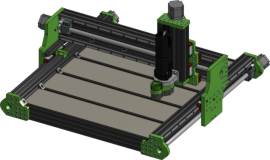LR/BS CNC Router
Discussion in 'CNC Mills/Routers' started by Ptiwee, Apr 26, 2020.
LR/BS CNC Router
Discussion in 'CNC Mills/Routers' started by Ptiwee, Apr 26, 2020.
An easy to source/easy to build, yet quite robust CNC router. This design has not yet be implemented.
Page 1 of 2
Page 1 of 2

